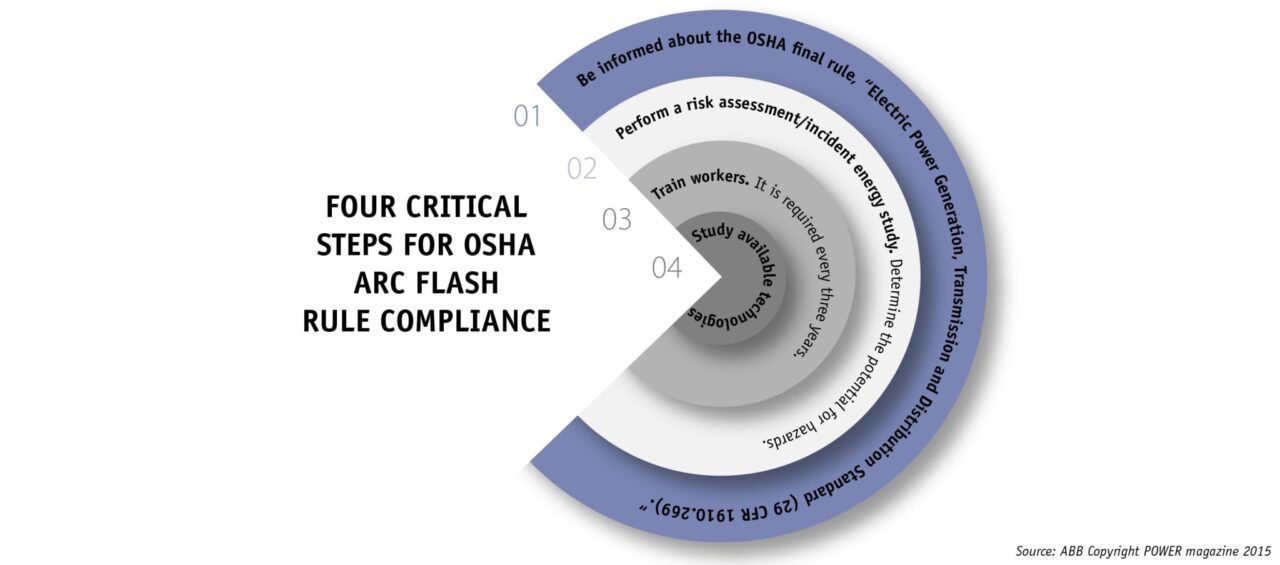Expert: OSHA’s Arc Flash Final Rule Will Save Lives
For Samy Faried, an ABB expert who has spent 15 years analyzing arc flash hazards, a new rule recently finalized by the Occupational Safety and Health Administration (OSHA) will save lives.
In April 2014, OSHA published its Final Rule for Electric Power Generation, Transmission and Distribution Standards (29 CFR 1910.269 and 1926 Subpart V), which applies to employers that operate or maintain generation, transmission, or distribution lines or equipment. This long awaited update covering electrical safety requirements and procedures has been in the works since 2005. OSHA promulgated the new rule because the provisions were out of date and inconsistent with more recently issued industry standards. Major changes involve updates to fall protection, arc flash hazard analysis, minimum approach distance requirements, and—what Faried considers most significant—arc flash protection requirements.
The agency estimates that compliance with the final rule will cost approximately $47 million to $50 million annually, but that it may save 20 lives and prevent 118 serious injuries every year.
In an interview with POWER this March, Faried (photo), a professional engineer who has authored an arc flash training program credited by the Florida State Fire College, explained what the arc flash aspect of the rule means for the electrical power sector, and how companies can achieve compliance with it.

POWER: What does the final rule mean for the power sector?
Faried: Essentially, the Final Rule has three key implications in the industry: preventing serious injuries; minimizing repair costs; and optimizing production.
First and foremost, the new standards aim to prevent serious and fatal injuries. Exposure to temperatures of 176F for one-tenth of a second can cause a second-degree burns, producing bubbles in the skin. Temperatures of 205F will cause a third-degree burn, leading to complete skin loss in the exposed area. To put those temperatures into perspective, an arc flash generate a temperature of 35,000F—which is four times the temperature of the sun’s surface. As you can see it really is a matter of life and death.
Going to the second implication, minimizing the repair cost, the process of conducting a risk analysis [as is required by the rule] would determine the hazard potential, the adequacy of electrical equipment, and the performance of protective systems for electrical equipment. This arc flash hazard analysis encompasses short circuit and relay coordination studies. These two studies reveal the adequacy and health of the electrical distribution system. As a result, you can upgrade and modify the system for optimum design conditions.
As for point number three, optimizing production will help minimize outages. Just to give you an idea, if an average-size pulp or paper mill loses power, costs can amount to more than $40,000 per hour.
According to OSHA, the employer must assess the workplace for arc flash hazards and ensure employees do not wear clothing that could melt onto their skin or that could ignite and continue to burn by the effective date of the rule, which was July 2014. But the rule also has other compliance deadlines. Would you clarify these?
Let me shed some light on the rule’s background. It goes all the way back to the 1980s, when people became more aware of the huge danger of arc flash. Today, there are several major entities involved in the establishment of [the industry’s existing] arc flash standards, along with OSHA. National Fire Protection Association (NFPA) Standards 70 and 70E contain requirements for warning labels and provide guidance for putting in place appropriate work practices to protect workers from injury. The Institute of Electrical and Electronics Engineers (IEEE) first prompted the effort in 2002 by publishing Standard 1584 on how to calculate incident energy to determine the required protective clothing and minimum approach distance, or safe working distance.
What is evident is that even though there were rules, a large fraction of the industry did not know about the rules or did not take them seriously. What’s new in OSHA’s rule is that it is more restrictive. OSHA’s final rule published in April 2014 and became a law in July 2014.
What needs immediate compliance?
Any deadline that has passed without compliance needs to be met immediately, or you incur the risk of heavy financial liabilities and possible criminal negligence charges. Past deadlines include that by July 2014, employers must have determined what personal protective equipment (PPE) is needed. By April 1, 2015, employers must have performed a risk assessment study to determine incident energy levels, as well as provide protective clothing and other protective equipment to meet the arc flash protection requirements.
The risk assessment study includes going to the field, collecting data, modeling the system, doing a short-circuit analysis, evaluating the electrical relay/fuse system, and determining the incident energy level—which is how many calories per centimeters squared (cal/cm2) an electrical system or device would emit.
This same calculation is used to measure arc flash. About 1.2 cal/cm2 can cause a second-degree burn. Studies that I’ve performed recently show that some electrical systems exceed 40 cal/cm2, at which point there is no PPE that can protect you while working on energized systems.
What should utilities prioritize when it comes to arc flash protection compliance?
Number one—above all—determine the potential for the hazard of arc flash. That means perform your risk assessment study. Everyone that operates an electrical distribution system must do a risk assessment. ABB is capable of doing this for them.
Number two is to take measures to minimize that arc flash hazard. After you do the study, assess the feasibility and the need to reduce the current, and minimize the clearing time of protective equipment. The third priority is to increase working distance and, if you can, operate the equipment remotely. Last, but not least, it is of great importance to reduce personnel exposure—about 75% of arc flash incidents happen when a worker is present or near the equipment.
Click for larger graphic
What are some technologies that could minimize arc flash risks?
One of the first things to do is to reduce short-circuit currents. If you’re designing a new system, you can control the impedance and the size of the transformer. Then you can specify arc resistant switchgear and motor control centers, such as those that direct gases and electrical explosion products from operators. Also, specify magnetically operated circuit breakers, which have far less maintenance requirements and minimize operator exposure compared to spring operated circuit breakers.
If you have an existing system, you should also consider reducing short circuit currents. ABB, for example, has a current limiter that is fast and extremely accurate. Not only does it trip at a specific current value, but also senses the rate of rise of current to avoid false tripping due to overloads. I consider it the best in the industry in terms of sensing current levels and its accuracy and ability to reduce short circuit currents.
Secondly, you should reduce the time of the arc duration. That can be accomplished by light-detecting and protective relays, which can detect light, detect arc, and respond accordingly. ABB REA relays detect the existence of an arc and trip the system in 2.5 milliseconds. These relays can also activate another device called an ultra-fast earthing switch, or UFES, which causes a three-phase short circuit in the system, ultimately driving the voltage to zero and essentially eliminating the arc flash.
You can also increase working distance by using smart racking systems, which allow you to be 20 feet away and still connect or disconnect circuit breakers. Or you can reduce personnel presence altogether.
What other important aspects of the rule should operators of electrical distribution systems heed?
Training is crucial because awareness of danger is fundamental for protection from it. It is required to train workers every three years. ABB has several training programs that are tailored to the skill level of different workers.
The rule also requires that employers update warning signs by April 1, 2015. Beyond a warning of high voltage danger, signs must now include incident energy value and the category of PPE required to protect people. If you have missed these important deadlines, it’s not too late to take corrective action, remembering that it will optimize production, minimize repair costs, and prevent serious injury.
—Samy Faried is an ABB Regional Business Development Manager and Field Application Engineer, based in Lake Mary, Florida. Samy may be reached at [email protected].
